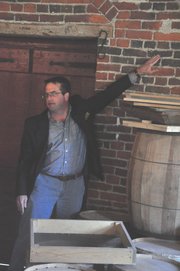Mike Henry, manager of Colvin Run Mill, points out the miller’s house on a tour of the grounds. Photo by Alex McVeigh.
Great Falls — While Colvin Run Mill’s claim to fame is its glimpse into life as it was 200 years ago, in the past, the Friends of Colvin Run Mill are just as concerned with its future.
The mill celebrated 200 years of existence last May, it was turned into a commercial mill by Philip Carper on land that was once owned by George Washington. It is one of the few brick mills remaining in Virginia.
Events at the Mill
Saturday, April 21: The Friends of Colvin Run Mill will host a road clean-up on their adopted part of Georgetown Pike, which is between Walker Road and Riverbend Road. Volunteers can meet at the Great Falls Library, 9830 Georgetown Pike, at noon. Bags for trash pickup will be provided, and the cleanup is expected to last two to three hours.
Saturday, April 28: Spring Tea seminar. Hosted by Laurie Bell of the Great Falls Tea Garden, the seminar will examine rare and unusual teas such as dark, brick, red and blue teas. Treats made with tea will be available for tasting. The event will take place at the mill, 10017 Colvin Run Road. Reservations can be made by calling 703-759-2771, the cost is $25.
"Following the bicentennial, we feel that it’s most important to work on innovative and creative ways to set new expectations for the future," said Bob Lundegard, president of the Friends of Colvin Run Mill.
One of their goals is to replace the current dairy barn, which was built by the county at the approximate location of the barn that was there 200 years ago, with a new visitor’s center. They have been raising money since 2003.
"The county has found money to make the drawings, and we have around $50,000 in our building fund, but we’re not ready to hand it over yet, not until we can put together an agreement with them about fundraising, which we expect in the next year or so," Lundegard said. "From there, we’ll need funds for bricks and mortar."
The upcoming widening of Leesburg Pike is of strong interest for the Friends of Colvin Run Mill and park staff. Since the mill is less than 100 feet from the current roadway, the two-lane expansion can make quite an impact.
The old mill pond, as well as other features, are located on park property south of Leesburg Pike, making them practically inaccessible to visitors.
"It feels like our visitors are separated from the other side, and we’d like to take advantage of the widening project to maybe put a tunnel underneath Route 7 to make the south side more accessible," Lundegard said. "In 1940, when the road shifted to its current location, there was a tunnel for the cows to go underneath Route 7."
Mike Henry, manager of Colvin Run Mill, said there are historical aspects to the area that go far beyond the 200 years of milling.
"We’ve found Native American artifacts and other signs from people that lived around here almost 9,000 years ago," he said. "Obviously most of our programming focuses on the last 200 years and European settlement. We’re hoping expansion south of Route 7 will help us with the exploration of that."
The group also assisted with the Colvin Run Street Fair that took place last May, hosted more than 100 people for the annual Society for the Preservation of Old Mills and increased their outreach to local schools.
"It’s amazing to think that things like bread and grain used to come from places like this," said Sam Archer, 8, of Great Falls, who visited the mill with his family Saturday. "It’s cool that water runs it, the same power now is the same power that ran it 200 years ago."
Lundegard estimated almost 10,000 children visited the mill last year, which he said represents as much as a 30 percent increase over years past.

